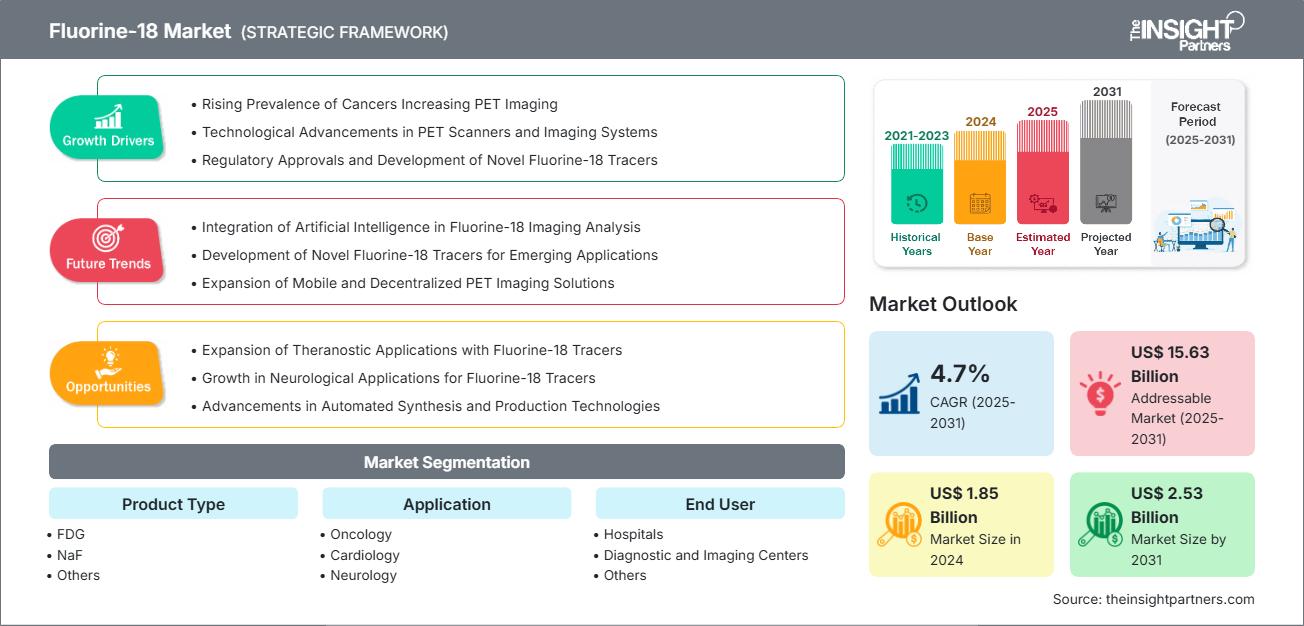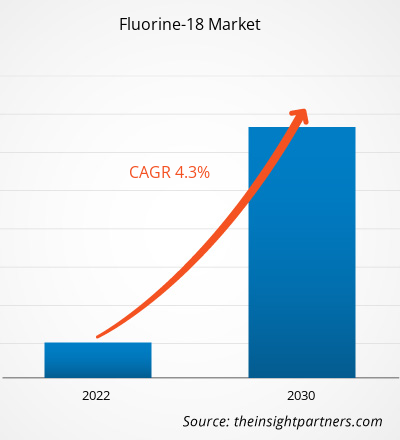Der Markt für Fluor-18 soll von 1,85 Milliarden US-Dollar im Jahr 2024 auf 2,53 Milliarden US-Dollar im Jahr 2031 anwachsen. Für den Zeitraum 2025–2031 wird eine durchschnittliche jährliche Wachstumsrate (CAGR) von 4,7 % erwartet.
Fluor-18 Marktanalyse
Das Marktwachstum wird durch die steigende Krebsrate, die zunehmende PET-Bildgebung, den technologischen Fortschritt bei PET-Scannern und Bildgebungssystemen sowie die behördliche Zulassung und Entwicklung neuartiger Fluor-18-Tracer vorangetrieben. Die Integration künstlicher Intelligenz in die Fluor-18-Bildanalyse und die Entwicklung neuartiger Fluor-18-Tracer tragen zur Marktentwicklung bei. Die Ausweitung theranostischer Anwendungen mit Fluor-18-Tracern und das Wachstum neurologischer Anwendungen für Fluor-18-Tracer dürften dem Fluor-18-Markt reichlich Wachstumschancen eröffnen.
Fluor-18 Marktübersicht
Der Fluor-18-Markt wird durch die weltweit steigende Zahl von Krebserkrankungen sowie Fortschritte in der Nuklearmedizin angetrieben. Neben der dominierenden Rolle von Fluordesoxyglukose (FDG), die mehr als 80 % des PET-CT-Marktes ausmacht, nimmt auch der Einsatz von PET in der Kardiologie und im zentralen Nervensystem rasant zu. Darüber hinaus dürfte die Einführung von Flyrcado (Flurpiridaz F 18) durch GE HealthCare im Jahr 2025 zur Myokardperfusionsbildgebung ein Meilenstein in der kardiovaskulären Diagnostik sein, da die Präzision der Technik erheblich verbessert wird. Krankenhäuser sind die führenden Endverbraucher des Sektors und generieren die größte Nachfrage. Die Eigenschaften des Isotops, beispielsweise seine begrenzte Lebensdauer (110 Minuten), haben zur Installation neuer Zyklotrone vor Ort geführt. Aufgrund der Verfügbarkeit modernster Technologie in der Region ist Nordamerika nach wie vor die bedeutendste geografische Region für diesen Markt. Allerdings hat sich der asiatisch-pazifische Raum aufgrund der steigenden Investitionen im Gesundheitswesen zu einem Markt mit großem Potenzial entwickelt und ist der Bereich mit den größten Marktwachstumsaussichten.
Sie erhalten kostenlos Anpassungen an jedem Bericht, einschließlich Teilen dieses Berichts oder einer Analyse auf Länderebene, eines Excel-Datenpakets sowie tolle Angebote und Rabatte für Start-ups und Universitäten.
Fluor-18-Markt: Strategische Einblicke

-
Holen Sie sich die wichtigsten Markttrends aus diesem Bericht.Dieses KOSTENLOSE Beispiel umfasst Datenanalysen, die von Markttrends bis hin zu Schätzungen und Prognosen reichen.
Markttreiber und Chancen für Fluor-18
Markttreiber:
- Steigende Krebshäufigkeit führt zu vermehrter Verwendung von PET-Bildgebung: Einer der Hauptgründe für die steigende Nachfrage nach Fluor-18-Radiotracern ist die weltweite Zunahme der Krebserkrankungen. Ein erheblicher Anteil der Krebserkrankungen sind Tumore, deren metabolisches Profiling durch Fluor-18-basierte Positronen-Emissions-Tomographie (PET)-Scans möglich ist.radiotracers is the worldwide increase in cancer incidence, with a significant proportion of cancers being those tumors whose metabolic profiling by Fluorine-18-based positron emission tomography (PET) scans is possible.
- Technologische Fortschritte bei PET-Scannern und Bildgebungssystemen: Die Fortschritte bei der Positronen-Emissions-Tomographie (PET)-Hardware und kombinierten Modalitäten haben den Einsatz klinisch relevanter Fluor-18-Radiotracer deutlich erhöht, sodass die Zahlen ihre bisherigen Grenzen als Diagnoseinstrumente überschreiten konnten.
- Zulassungen und Entwicklung neuartiger Fluor-18-Tracer: Einer der Hauptfaktoren für den Marktanstieg für innovative Fluor-18-markierte Tracer ist die steigende Zahl behördlicher Zulassungen. Neben der Erweiterung des therapeutischen Fensters konnten diese Tracer auch die Spezifität der Krankheit über ein breites Spektrum von Pathologien hinweg erhöhen, was zu einer raschen Weiterentwicklung ihrer klinischen Integration und Produktion führte.
Marktchancen:
- Erweiterung der Theranostik-Anwendungen mit Fluor-18-Tracern: Die Kombination von Fluor-18-PET mit Theranostik-Systemen kann den Weg für eine grundlegende Veränderung auf dem Fluor-18-Markt ebnen, d. h. sowohl die diagnostische Genauigkeit als auch die Therapieüberwachung können ermöglicht werden.
- Wachstum bei neurologischen Anwendungen für Fluor-18-Tracer: Eine wichtige Chance für den Fluor-18-Markt ist die zunehmende Nutzung des Bereichs Neuroimaging, die auf die zunehmende Häufigkeit von Erkrankungen des Nervensystems zurückzuführen ist, unter denen Alzheimer und andere Demenzerkrankungen die führende Rolle spielen.
- Fortschritte bei automatisierten Synthese- und Produktionstechnologien: Eine der wichtigsten Neuerungen, die die Produktion von Fluor-18-Radiotracern deutlich vereinfacht haben, ist die Erfindung automatisierter Synthesemodule. Diese Innovationen bieten große Chancen, die Produktionseffizienz zu verbessern, Kosten zu sparen und neue Märkte zu erschließen.
Fluor-18-Marktbericht – Segmentierungsanalyse
Der Fluor-18-Markt ist in verschiedene Segmente unterteilt, um einen besseren Überblick über seine Funktionsweise, sein Wachstumspotenzial und die neuesten Trends zu geben. Nachfolgend finden Sie den Standardsegmentierungsansatz, der in den meisten Branchenberichten verwendet wird:
Nach Produkttyp:
- FDG: FDG (Fluordesoxyglucose) ist der wichtigste Radiotracer für die Positronen-Emissions-Tomographie (PET), da es den Glukosestoffwechsel in pathologischem Gewebe sichtbar macht. Die Halbwertszeit von FDG beträgt etwa 110 Minuten. Daher muss es vor Ort in einem Zyklotron produziert werden, um eine schnelle Lieferung an die Bildgebungszentren zur Verwendung noch am selben Tag zu ermöglichen.
- NaF: Natriumfluorid (NaF) gilt als wirksamstes Mittel zur Lokalisierung von Knochenveränderungen, insbesondere bei metastasierten Knochenerkrankungen. Daher ist es das wichtigste Diagnoseinstrument bei Krebserkrankungen. Da das Produkt eine hohe Knochenaffinität aufweist, ermöglicht es die Aufnahme präziser Bilder von Skelettstrukturen und bietet dadurch eine höhere Sensitivität als herkömmliche Knochenszintigraphiemittel.
- Sonstige: Die Kategorie „Sonstige“ umfasst mehrere Nicht-FDG-Radiotracer wie FLT (Fluorthymidin), FMISO (Fluormisonidazol) und FET (Fluorethyltyrosin), die zur Entwicklung neuer diagnostischer Bereiche unter Verwendung der PET-Bildgebungstechnologie führen. Die Tracer sind die Hauptquelle für seltene Indikationen in den Bereichen Onkologie, Neurologie und Hypoxie-Bildgebung.
Nach Anwendung:
- Onkologie
- Kardiologie
- Neurologie
- Sonstige
Nach Endbenutzerbranche:
- Krankenhäuser
- Diagnose- und Bildgebungszentren
- Sonstige
Jeder Endbenutzer auf dem Fluor-18-Markt hat unterschiedliche Handhabungs-, Sicherheits- und Regulierungsanforderungen, die die Auswahl der Geräte und die Betriebsprotokolle beeinflussen.
Nach Geografie:
- Nordamerika
- Europa
- Asien-Pazifik
- Lateinamerika
- Naher Osten und Afrika
Der Fluor-18-Markt im asiatisch-pazifischen Raum dürfte das schnellste Wachstum verzeichnen. Die steigende Nachfrage nach Positronen-Emissions-Tomographie (PET), bedingt durch steigende Krebsfälle und den Ausbau der Gesundheitsinfrastruktur, dürfte den Markt antreiben.
Regionale Einblicke in den Fluor-18-Markt
Die Analysten von The Insight Partners haben die regionalen Trends und Faktoren, die den Fluor-18-Markt im Prognosezeitraum beeinflussen, ausführlich erläutert. In diesem Abschnitt werden auch die Marktsegmente und die geografische Lage von Fluor-18 in Nordamerika, Europa, Asien-Pazifik, dem Nahen Osten und Afrika sowie Süd- und Mittelamerika erläutert.
Umfang des Fluor-18-Marktberichts
| Berichtsattribut | Details |
|---|---|
| Marktgröße im Jahr 2024 | 1,85 Milliarden US-Dollar |
| Marktgröße bis 2031 | 2,53 Milliarden US-Dollar |
| Globale CAGR (2025 – 2031) | 4,7 % |
| Historische Daten | 2021–2023 |
| Prognosezeitraum | 2025–2031 |
| Abgedeckte Segmente |
Nach Produkttyp
|
| Abgedeckte Regionen und Länder |
Nordamerika
|
| Marktführer und wichtige Unternehmensprofile |
|
Dichte der Marktteilnehmer für Fluor-18: Verständnis ihrer Auswirkungen auf die Geschäftsdynamik
Der Fluor-18-Markt wächst rasant. Die steigende Endverbrauchernachfrage ist auf Faktoren wie veränderte Verbraucherpräferenzen, technologische Fortschritte und ein stärkeres Bewusstsein für die Produktvorteile zurückzuführen. Mit der steigenden Nachfrage erweitern Unternehmen ihr Angebot, entwickeln Innovationen, um den Bedürfnissen der Verbraucher gerecht zu werden, und nutzen neue Trends, was das Marktwachstum weiter ankurbelt.

- Überblick über die wichtigsten Akteure auf dem Fluor-18-Markt
Fluor-18 Marktanteilsanalyse nach Geografie
Der asiatisch-pazifische Raum dürfte in den nächsten Jahren das stärkste Wachstum verzeichnen. Auch die Schwellenmärkte in Lateinamerika, dem Nahen Osten und Afrika bieten Fluor-18-Anbietern zahlreiche ungenutzte Expansionsmöglichkeiten.
Der Fluor-18-Markt wächst in den einzelnen Regionen unterschiedlich. Dies ist auf die zunehmende Verbreitung von Krebserkrankungen und anderen Erkrankungen, den technologischen Fortschritt bei PET-Scannern und Bildgebungssystemen, behördliche Zulassungen und die Entwicklung von F-18-Tracern zurückzuführen. Nachfolgend finden Sie eine Übersicht über Marktanteile und Trends nach Regionen:
1. Nordamerika
- Marktanteil: Hält einen bedeutenden Anteil des Weltmarktes
-
Haupttreiber:
- Die steigende Nachfrage nach PET-Bildgebung in der Onkologie, die zunehmende Verbreitung von Krebs, Fortschritte bei Radiopharmazeutika und wachsende Investitionen in die nuklearmedizinische Infrastruktur
- Trends: Fortschritte in der radiopharmazeutischen Produktion
2. Europa
- Marktanteil: Erheblicher Anteil aufgrund der frühen Einführung von Fluor-18 für die PET-Bildgebung
-
Haupttreiber:
- Steigende Krebsfälle, zunehmende Präferenz für PET-Bildgebung, unterstützende staatliche Gesundheitsinitiativen und zunehmender Einsatz von Radiopharmazeutika in der personalisierten und Präzisionsmedizin.
- Trends: Zunehmende Integration von Fluor-18 in die personalisierte Medizin
3. Asien-Pazifik
- Marktanteil: Am schnellsten wachsende Region mit jährlich steigendem Marktanteil
-
Haupttreiber:
- Steigende Gesundheitsausgaben, zunehmendes Bewusstsein für die Früherkennung von Krebs, Ausbau der PET-Bildgebungseinrichtungen und zunehmende Investitionen in die nuklearmedizinische und radiopharmazeutische Forschung.
- Trends: Wachsende Partnerschaften zwischen Krankenhäusern und Radiopharmaunternehmen
4. Süd- und Mittelamerika
- Marktanteil: Wachsender Markt mit stetigem Fortschritt
-
Haupttreiber:
- Zunehmende Krebsfälle, Verbesserung der Gesundheitsinfrastruktur, steigendes Bewusstsein für Nuklearmedizin und zunehmende Nutzung von PET-Bildgebungstechnologien in städtischen Zentren.
- Trends: Zunehmende Modernisierung des Gesundheitswesens
5. Naher Osten und Afrika
- Marktanteil: Zwar klein, aber schnell wachsend
-
Haupttreiber:
- Ausweitung der Möglichkeiten der diagnostischen Bildgebung, steigende staatliche Investitionen in das Gesundheitswesen, zunehmende Verbreitung chronischer Krankheiten und verbesserter Zugang zu Radiopharmazeutika.
- Trends: Zunehmende staatliche Initiativen zur Krebsdiagnose
Dichte der Marktteilnehmer für Fluor-18: Verständnis ihrer Auswirkungen auf die Geschäftsdynamik
Hohe Marktdichte und Wettbewerb
Aufgrund der Präsenz etablierter Akteure wie Lantheus Holdings, Advanced Accelerator Applications, Curium Pharma und Jubilant Pharma Limited, die ebenfalls zur Wettbewerbslandschaft in verschiedenen Regionen beitragen, herrscht ein starker Wettbewerb.
Dieser hohe Wettbewerbsdruck zwingt Unternehmen dazu, sich durch folgende Angebote von der Masse abzuheben:
- Erweiterte Sicherheitsfunktionen
- Mehrwertdienste wie Analytik und vorausschauende Wartung, Betriebsanalytik in Echtzeit und Installation
- Wettbewerbsfähige Preismodelle
- Starker Kundensupport und einfache Integration
Chancen und strategische Schritte
- Die Entwicklung neuer F-18-markierter Radiopharmazeutika für die Diagnose und gezielte Therapie in der Onkologie, Neurologie und Kardiologie beschleunigt das Marktwachstum. Der Ausbau der PET-Bildgebungsmöglichkeiten und die Einführung der Präzisionsmedizin kurbeln die Nachfrage nach F-18-Produkten an, insbesondere da sie eine frühzeitige Krebserkennung und eine verbesserte Behandlungsüberwachung ermöglichen.
- Führende Akteure der Branche gehen exklusive Partnerschaften für den Technologietransfer und die regulatorische Unterstützung ein, insbesondere in Regionen mit hoher Krankheitsprävalenz wie China.
-
Die jüngsten FDA- und europäischen Zulassungen für neuartige F-18-Tracer (z. B. Flotufolastat, Pylclari) ermöglichen eine verbesserte Bildgebung von Prostata- und Herz-Kreislauf-Erkrankungen. Unternehmen investieren in die Forschung, um die Zyklotronausbeute zu verbessern, die Kosten zu senken und die Isotopenproduktion zu dezentralisieren, um einen breiteren Marktzugang zu ermöglichen.
Weitere im Rahmen der Untersuchung analysierte Unternehmen:
- GE Healthcare
- Siemens Healthineers
- Kardinalgesundheit
- Lantheus Medical Imaging
- Curium Pharma
- IBA Radiopharma Solutions
- Eckert & Ziegler Radiopharma
- Erweiterte Beschleunigeranwendungen
- Bracco Imaging
- Jubilant Radiopharma
- Positron Corporation
- Nordion (Kanada) Inc.
- Blue Earth Diagnostics
- PETNET Solutions Inc.
- SOFIE Biosciences
Fluor-18-Marktnachrichten und aktuelle Entwicklungen
- Lantheus und GE HealthCare haben eine exklusive Lizenzvereinbarung für das Prostatakrebs-Bildgebungsmittel PYLARIFY in Japan bekannt gegeben. Lantheus Holdings, Inc. und GE HealthCare haben eine exklusive Lizenzvereinbarung bekannt gegeben, wonach GE HealthCare das Piflufolastat F18 (PYLARIFY auf dem US-Markt) von Lantheus in Japan für die Prostatakrebsdiagnostik und die begleitende Diagnostik entwickeln, herstellen und vermarkten wird.
- GE HealthCare hat die FDA-Zulassung für den Injektions-PET-Radiotracer Flyrcado (Flurpiridaz F 18) zur verbesserten Diagnose der koronaren Herzkrankheit erhalten. Der von der FDA zugelassene Flurpiridaz F 18-PET-Radiotracer Flyrcado von GE HealthCare bietet eine höhere diagnostische Wirksamkeit bei Patienten mit bekannter oder vermuteter koronarer Herzkrankheit (KHK) im Vergleich zu SPECT MPI, dem vorherrschenden Verfahren in der Nuklearkardiologie.
- Lantheus erhält von der US-amerikanischen Food and Drug Administration (FDA) die Zulassung für PYLARIFY (Piflufolastat F 18)-Injektion, das erste und einzige kommerziell erhältliche PSMA-PET-Bildgebungsmittel für Prostatakrebs. Lantheus Holdings erhielt von der US-amerikanischen Food and Drug Administration (FDA) die Zulassung für PYLARIFY, ein F 18-markiertes, auf das prostataspezifische Membranantigen (PSMA) ausgerichtetes Positronen-Emissions-Tomographie-Bildgebungsmittel (PET) zur Erkennung von vermuteten Metastasen oder Rezidiven bei Prostatakrebs. PYLARIFY ist das erste und einzige kommerziell erhältliche, zugelassene PSMA-PET-Bildgebungsmittel für Prostatakrebs.
Marktbericht zu Fluor-18 – Umfang und Ergebnisse
Der Bericht „Marktgröße und Prognose für Fluor-18 (2021–2031)“ bietet eine detaillierte Analyse des Marktes, die die folgenden Bereiche abdeckt:
- Fluor-18-Marktgröße und -prognose auf globaler, regionaler und Länderebene für alle wichtigen Marktsegmente, die im Rahmen des Berichts abgedeckt sind
- Fluor-18-Markttrends sowie Marktdynamiken wie Treiber, Einschränkungen und wichtige Chancen
- Detaillierte PEST- und SWOT-Analyse
- Fluor-18-Marktanalyse mit wichtigen Markttrends, globalen und regionalen Rahmenbedingungen, wichtigen Akteuren, Vorschriften und jüngsten Marktentwicklungen
- Branchenlandschaft und Wettbewerbsanalyse mit Marktkonzentration, Heatmap-Analyse, prominenten Akteuren und jüngsten Entwicklungen für den Fluor-18-Markt
- Detaillierte Firmenprofile
- Historische Analyse (2 Jahre), Basisjahr, Prognose (7 Jahre) mit CAGR
- PEST- und SWOT-Analyse
- Marktgröße Wert/Volumen – Global, Regional, Land
- Branchen- und Wettbewerbslandschaft
- Excel-Datensatz
Aktuelle Berichte
Erfahrungsberichte
Grund zum Kauf
- Fundierte Entscheidungsfindung
- Marktdynamik verstehen
- Wettbewerbsanalyse
- Kundeneinblicke
- Marktprognosen
- Risikominimierung
- Strategische Planung
- Investitionsbegründung
- Identifizierung neuer Märkte
- Verbesserung von Marketingstrategien
- Steigerung der Betriebseffizienz
- Anpassung an regulatorische Trends






















 Kostenlose Probe anfordern für - Fluor-18-Markt
Kostenlose Probe anfordern für - Fluor-18-Markt